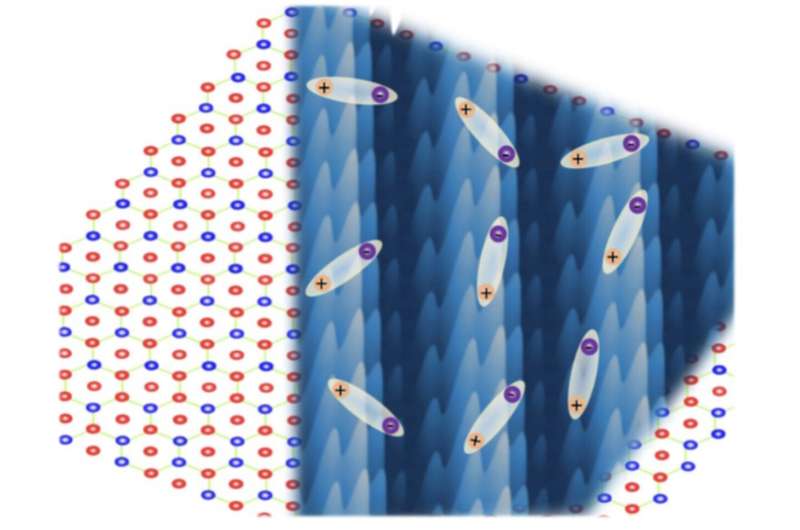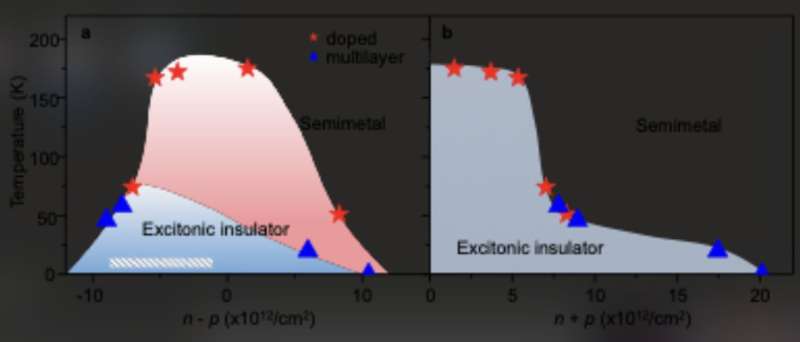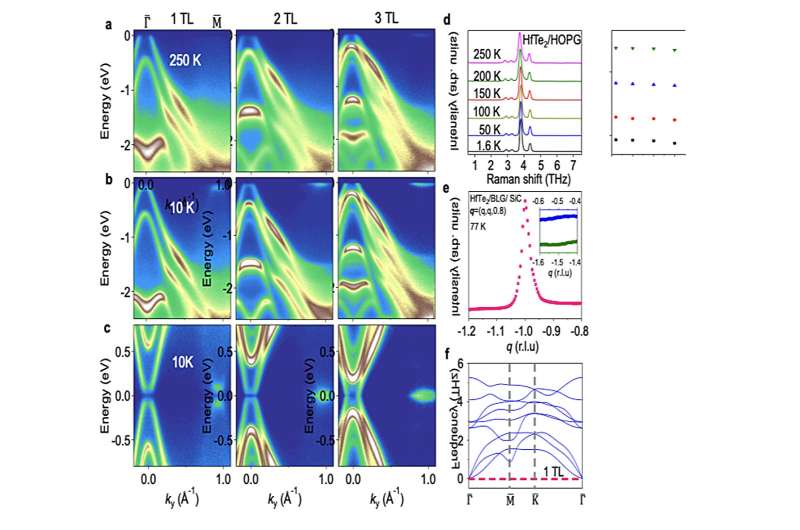February 9, 2024 feature
This article has been reviewed according to Science X's editorial process and policies. Editors have highlighted the following attributes while ensuring the content's credibility:
fact-checked
peer-reviewed publication
trusted source
proofread
Evidence that atomically thin hafnium telluride is an excitonic insulator

The condensation of excitons with non-zero momentum can give rise to so-called charge density waves (CDW). This phenomenon can prompt the transition of materials into a fascinating new quantum phase, known as an excitonic insulator.
Researchers at Shanghai Jiao Tong University and other institutes recently carried out a study exploring the possibility that this metal-insulator transition could occur in the atomically thin semi-metallic HfTe2. Their observations, outlined in Nature Physics, unveiled possible excitonic CDW and metal-insulator transitions in the atomically thin material.
"The formation of CDW in materials has various mechanisms (e.g., Fermi surface nesting, lattice distortions, etc.) and exclusion of other CDW formation mechanisms is the key to identifying the existence of an excitonic insulator," Peng Chen, corresponding author of the paper, told Phys.org.
"Our research team previously conducted a series of studies on two-dimensional transition metal dichalcogenides including TiSe2 and ZrTe2 to explore this novel phenomenon. Unfortunately, lattice distortion is still evidenced in the calculated phonon dispersions, although it might not be the main driving force in these materials."
Building on their previous works, the researchers set out to probe the existence of CDW and a metal-insulator transition in thin films of another material, namely HfTe2. After successfully observing both these phenomena, they performed phonon calculations to validate their observations.

These calculations showed that single-layer HfTe2 does not exhibit structural instability. In addition, Raman and X-ray diffraction measurements did not unveil any significant lattice distortions, thus providing strong evidence for the electronic origin of the metal-insulator transition in single-layer HfTe2.
"A notable feature of exciton condensation is the sensitivity to carrier concentration near the Fermi surface," Peng explained. "A small number of carriers and balanced concentration of both n-type and p-type carriers can in principle benefit the exciton condensation. We found that a small amount of n-type doping significantly increased the transition temperature of single-layer HfTe2, which is different from other types of transition mechanism like Peierls-type CDW."
The recent findings gathered by Peng and his researchers suggest that atomically thin HfTe2 could be the first known excitonic insulator in a natural solid with a purely electronic transition origin. The researchers have so far validated their results via various calculations and analyses.

"By lowering the material dimensionality, the screening effects around the Fermi level can be reduced which benefits the exciton condensation," Peng said. "We successfully prepared single-layer and multi-layer HfTe2 thin films by molecular beam epitaxy. Angle-resolved photoemission spectroscopy measurements revealed a metal-insulator transition when the thickness was less than three layers. The valence band top formed a flat band at low temperatures, opening a gap near the Fermi surface. Additionally, folded bands appeared near the point, a typical feature of CDW formation."
The new excitonic insulator uncovered by this research team could lay the foundation for additional studies focusing on exotic quantum effects deriving from interaction between excitonic insulating states and other orderings (e.g., topology and spin-correlated states). In their future work, Peng and his colleagues plan to examine the quantum insulator phase they observed further, to better understand its underlying physics.
"Unlike traditional Cooper pairs in superconductors, excitons have a larger binding energy, making them conducive to condensation at higher temperatures," Peng added. "Therefore, the study of excitonic insulators is of great importance for understanding phenomena such as high-temperature superconductivity and superfluidity. As the formation of exciton is very sensitive to the number of carriers and band gap, external stimuli such as electric gating or strain can be used to delicately control the carrier concentration or band structure and thus the order parameter of the electron-hole coherence."
More information: Qiang Gao et al, Observation of possible excitonic charge density waves and metal–insulator transitions in atomically thin semimetals, Nature Physics (2024). DOI: 10.1038/s41567-023-02349-0
Journal information: Nature Physics
© 2024 Science X Network




















